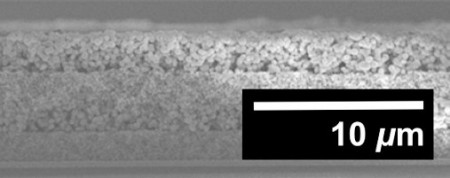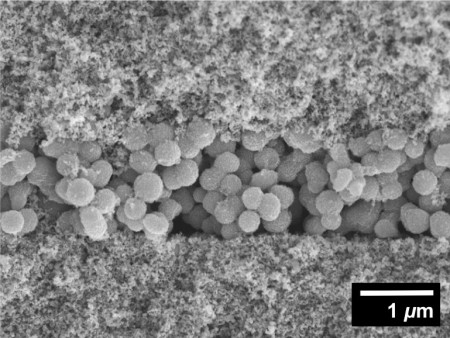Aug
2
Dye Based Photovoltaic Cells Could Get an Big Upgrade
August 2, 2011 | Leave a Comment
Dye-sensitized solar cells (DSSC), the ones in mind when printed solar cells or ‘roll to roll’ cell production is discussed, have an upgrade in the works at the University of Minnesota. Bin Liu and Eray S. Aydil have engineered alternating layers of nanometer and micrometer particles that send light ricocheting through layers of microscopic spheres, increasing its electricity-generating potential by 26 percent.
A couple of years ago there were chastising comments on solar cell claims, but this team’s work is peer reviewed and published by the Journal of Renewable and Sustainable Energy at the American Institute of Physics. That tends to lend great credibility to the team’s assertion. Also, the team’s work starts its calculations in a sensible zone at about 10% efficiency.
The DSSC cell with the TiO2 photoanodes improvement is significantly better in the visible and near infrared range of the electromagnetic spectrum. Moreover, the surface area remains the same. The improvement comes from enhanced light scattering by porous TiO2 nanospheres.
Titanium dioxide is a photosensitive material that’s less expensive than the more traditional silicon solar cells. Silicon cells are rapidly approaching the theoretical limit of their efficiency. Current DSSC cells based on TiO2 designs, however, are only about 10 percent efficient. One reason for this low efficiency is that light from the infrared portion of the spectrum is not easily absorbed in the solar cell.
The Minnesota team engineered a new layered design described in the paper. The spheres and the layers work to increase the path of the light through the solar cell and convert more of the electromagnetic spectrum into electricity. The cells consist of micrometer-scale spheres with nanometer pores sandwiched between layers of nanoscale particles. The TiO2 spheres act like tightly packed bumpers on a pinball machine, causing photons to bounce around before eventually making their way through the cell.
Each time the photon interacts with one of the spheres, a small charge is produced. The interfaces between the layers also help enhance the efficiency by acting like mirrors and keeping the light inside the solar cell where it can be converted to electricity.
The team says the strategy to increase light-harvesting efficiency can be easily integrated into current commercial DSSC production. If the team is right, a 26% increase is going to change the market dramatically.
The innovation isn’t likely to stop here. The sphere sizes could be reduced even more, the layer structure isn’t optimized yet, and other insights may offer more improvement.
The dye based cell industry will need to closely look into this work. Costs are not discussed, but TiO2 an inexpensive product. Getting the spheres sized and sorted might be a challenge. But getting to 12 or 13% efficiency is a major improvement, well worth the pursuit now that a solution is known.



